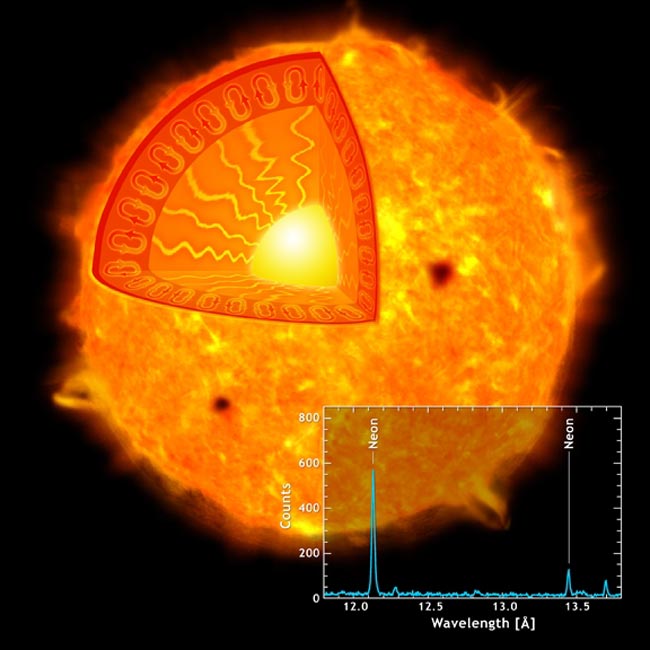
The Sun likely containsnearly three times more neon than previously thought, according to a new study.
The finding, if shown to beaccurate, solves a theoretical problem regarding how stars in general work.
The question of the Sun'sneon abundance has been a sensitive topic among astronomers in recent years.
"Understanding the waythe Sun works is the bottom rung in a ladder to understanding how the rest ofthe universe works," said Jeremy Drake of the Harvard-Smithsonian Centerfor Astrophysics.
In the past, astrophysicistsbased their solar model on data collected from studies that measured the waypressure waves propagate throughout the Sun.
The model was put intoquestion, however, when their value for the neon abundance in the Sun differedfrom those calculated using other techniques.
One of these techniquesinvolved capturing particles from the solar wind, a stream of charged particlesthat continuously streams from the Sun, and tallying up the total number andtype of atoms present from each element.
Get the Space.com Newsletter
Breaking space news, the latest updates on rocket launches, skywatching events and more!
Another involved X-rays;neon does not appear in the visible spectrum of light but it shines brightly inX-rays.
Based on these techniques,astronomers came up with a value for the Sun's neon concentration that differedfrom the value used in the astrophysicist's model by a factor of three.
"When astrophysicistsplugged in these new values, their model broke," Drake said.
Drake said the disagreementabout the concentration of neon may have been due to problems with both thesolar wind technique and the X-ray method.
In the case of the solarwind, the Sun accelerates a particle differently depending on its mass andcharge -- things that vary from element to element.
With X-rays, the problem isone of distance. Because Earth is so close to the Sun, relatively speaking,scientists can't look at the solar furnace in its entirety, and must insteadsettle for examining different parts separately.
When viewed from such aclose distance, different elements appear in different concentrations indifferent parts of the Sun, Drake explained, and it is difficult to say whicharea, if any, is an accurate representation of the Sun's chemical makeup.
Drake and his colleaguePaola Testa from the Massachusetts Institute of Technology got around theseproblems by measuring the neon abundance of 21 nearby Sun-like stars usingNASA's Chandra X-ray Observatory.
By stepping back, theymeasured the average X-ray emission from the stars.
What the researchers foundwas that the nearby stars contained three times more neon than was calculatedfor the Sun.
The implication was clear."Either the Sun is a freak in its stellar neighborhood, or it contains alot more neon than we think," said Paola Testa from MassachusettsInstitute of Technology and another study team member.
Drake said the sametechnique could be used on our own Sun, if not for one problem: the detectorson Chandra's instruments would fry because of the heat.
The study is detailed in theJuly 28 issue of the journal Nature.
- Live Sun Cam
- First Artificial Neon Sky Show Created
- Voyage Inside the Sun
Join our Space Forums to keep talking space on the latest missions, night sky and more! And if you have a news tip, correction or comment, let us know at: community@space.com.
Ker Than is a science writer and children's book author who joined Space.com as a Staff Writer from 2005 to 2007. Ker covered astronomy and human spaceflight while at Space.com, including space shuttle launches, and has authored three science books for kids about earthquakes, stars and black holes. Ker's work has also appeared in National Geographic, Nature News, New Scientist and Sky & Telescope, among others. He earned a bachelor's degree in biology from UC Irvine and a master's degree in science journalism from New York University. Ker is currently the Director of Science Communications at Stanford University.












